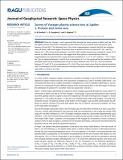Survey of Voyager plasma science ions at Jupiter: 1. Analysis method
Author(s)
Dougherty, L. P.; Bodisch, K. M.; Bagenal, Fran.
DownloadBodisch2017.pdf (2.503Mb)
PUBLISHER_POLICY
Publisher Policy
Article is made available in accordance with the publisher's policy and may be subject to US copyright law. Please refer to the publisher's site for terms of use.
Terms of use
Metadata
Show full item recordAbstract
When the Voyager 1 and 2 spacecraft fl ew through the Jovian system in March and July 1979, the Plasma Science instruments measured ions and electrons in the Io plasma torus and plasma sheet between 4.9 and 42 R J . The dominant ions in the Jovian magnetosphere comprise the fi rst few ionization states of atomic sulfur and oxygen. We present here an analysis of minor ion species H + ,Na + , and SO 2 + . Protons are 1 – 20% of the plasma between 5 and 30 R J with variable temperatures ranging by a factor of 10 warmer or colder than the heavy ions. We suggest that these protons, measured deep inside the magnetosphere, are consistent with a source from the ionosphere of ~1.5 – 7.5 × 10 27 protons s 1 (2.5 – 13 kg/s). Na + ions are detected between 5 and 40 R J at an abundance of 1 to 10%, produced by the ionization of the extended neutral cloud emanating from Io that has been observed since 1974. SO 2 + ions are detected between 5.31 and 5.07 R J at an abundance of 0.1 – 0.6%. These ions clearly come from the plasma interaction with Io ’ s atmosphere, but the exact processes whereby atmospheric molecules escape Io and end up as ions well inside Io ’ s orbit are not clear.
Date issued
2017-08Department
Massachusetts Institute of Technology. Department of Earth, Atmospheric, and Planetary SciencesJournal
Journal of Geophysical Research: Space Physics
Publisher
American Geophysical Union (AGU)
Citation
Bagenal, F., L. P. Dougherty, K. M. Bodisch, J. D. Richardson, and J. M. Belcher. “Survey of Voyager Plasma Science Ions at Jupiter: 1. Analysis Method.” Journal of Geophysical Research: Space Physics 122, no. 8 (August 2017): 8241–8256.
Version: Final published version
ISSN
21699380